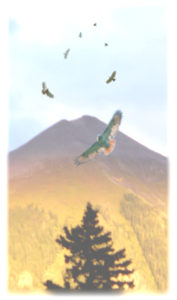I was having a conversation this morning with one of my meditation students, and we got onto the question of action and emptiness. It’s often confusing when to back off from activity and take a break. The worried mind wonders, “Am I copping out?” Shouldn’t I keep pushing? Who the hell am I if I’m not striving to make life happen? Will the world fall apart if I stop for a moment?”
The question of when to push and when to back off has been with us ever since Adam wanted sex and Eve wanted an apple. But remember that action and emptiness are complementary forces. If we didn’t take action most things would stay in the realm of wishful thinking and life can drift by until we look back and wonder what happened. At the same time doing creates its own habits, fixations, and accumulated noise that builds to a point where our instincts and ability to process information become compromised. In short, we get stuck in a rut.
In the ancient Chinese concept of how the universe works, Yang and Yin describe the interdependent movement of becoming full and becoming empty, action and inaction. When in the process of pursuing a goal we become so stuffed with strategy and activity that we can no longer digest what’s going on, it’s time to take a break, to purposely relinquish control in order to assimilate what we’ve been trying to consume so forcefully. Conversely, when we’ve taken that break to a point when it’s no longer rejuvenating or enjoyable, it’s a sign that we may have shifted into procrastination. It’s time to gather our forces and move again.
Pragmatically, it can be as simple as paying attention to what’s going on inside of you. Take a moment to notice how your body responds to what your mind is thinking. Is your stomach tight and your breath shallow? Are you just going through the motions? Deciding to hit pause and go for a walk can be as practical as the tasks and errands that can so easily consume our entire day. A beneficial practice to try out when you actually take that pause is to be mindful, accepting, and kind to yourself within the pause. Place your attention on your breath, your physical sensations. Be mindful of whatever is passing though you in the present moment. If you notice the sensations of resistance, of suffering, you don’t need to take corrective action. Just acknowledge and intend a bit of love and kindness for yourself. Step back from the search for problems, solutions, and identity by choosing what you place your attention on. That’s what the pause is for.
In the skill of life, in order to find sweetness it’s necessary to stay relaxed within the complexity. It’s just as important to know what muscles not to use as well as what to use. You might say learning when to let go and allow the emptiness to speak helps us to navigate where the wisdom is within the pressures of life.
Life works that way. The heartbeat that keeps our lifeblood flowing requires movement, a flowing from tension to relaxation. Resist either and you’ve got a problem. Whether we use the eastern concept of emptiness or the western concept of stillness, it’s about giving ourselves the silence to sort out what is important in life. Thriving and flourishing requires both action and emptiness.
Woo Du-An, internationally known shaman, healer and spiritual teacher, lives in the Colorado Rocky Mountains

